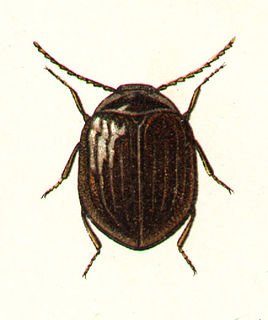| Eubriinae | |
|---|---|
 | |
| Eubria palustris adult | |
| Scientific classification | |
| Kingdom: | |
| Phylum: | |
| Class: | |
| Order: | |
| Suborder: | |
| Superfamily: | |
| Family: | |
| Subfamily: | Eubriinae Lacordaire, 1857 |
| Genera | |
Eubriinae is an aquatic beetle subfamily in the family Psephenidae. [1] [2]
| Eubriinae | |
|---|---|
 | |
| Eubria palustris adult | |
| Scientific classification | |
| Kingdom: | |
| Phylum: | |
| Class: | |
| Order: | |
| Suborder: | |
| Superfamily: | |
| Family: | |
| Subfamily: | Eubriinae Lacordaire, 1857 |
| Genera | |
Eubriinae is an aquatic beetle subfamily in the family Psephenidae. [1] [2]
Phoebe may refer to:

Passalidae is a family of beetles known variously as "bessbugs", "bess beetles", "betsy beetles" or "horned passalus beetles". Nearly all of the 500-odd species are tropical; species found in North America are notable for their size, ranging from 20–43 mm, for having a single "horn" on the head, and for a form of social behavior unusual among beetles.
Enigma, aenigma, or The Enigma may refer to:

Phyllophaga is a very large genus of New World scarab beetles in the subfamily Melolonthinae. Common names for this genus and many other related genera in the subfamily Melolonthinae are May beetles, June bugs, and June beetles. They range in size from 12 to 35 mm and are blackish or reddish-brown in colour, without prominent markings, and often rather hairy ventrally. These beetles are nocturnal, coming to lights in great numbers.

Water-penny beetles are a family of 272 species of aquatic beetles found on all continents except Antarctica, in both tropical and temperate areas. The young, which live in water, resemble tiny pennies. The larvae feed – usually nocturnally – on algae on rock surfaces. The presence of water-penny larvae in a stream can be used as a test for the quality of the water, as they are pollution-sensitive. They cannot live in habitats where rocks acquire a thick layer of algae, fungi, or inorganic sediment. Therefore, their presence along with other diverse phyla signifies good-quality water. They are around 6 to 10 millimeters in length.
Colophon may refer to:

The minute tree-fungus beetles, family Ciidae, are a sizeable group of beetles which inhabit Polyporales bracket fungi or coarse woody debris. Most numerous in warmer regions, they are nonetheless widespread and a considerable number of species occur as far polewards as Scandinavia for example.

Scirtidae is a family of beetles (Coleoptera). These beetles are commonly referred to as marsh beetles, as the larvae are typically associated with stagnant water, but can be found in flowing water. Adults prefer decomposing plant material near the water's edge. More than an estimated 600 species are known worldwide, distributed among at least 60 genera.
Harley Proctor Brown was an American biologist and an expert in certain types of aquatic beetles. He described over forty new species in his career.

Psephenus is a genus of water penny beetles in the family Psephenidae. There are about 13 described species in Psephenus.
Dicranopselaphus is a genus of water penny beetles in the family Psephenidae. There are about seven described species in Dicranopselaphus.
Ectopria leechi is a species of water penny beetle in the family Psephenidae. It is found in North America.
Ectopria is a genus of water penny beetles in the family Psephenidae. There are about nine described species in Ectopria.
Acneus quadrimaculatus is a species of water penny beetle in the family Psephenidae. It is found in North America.
Acneus is a genus of water penny beetles in the family Psephenidae. There are at least four described species in Acneus.
Eubrianax is a genus of water penny beetles in the family Psephenidae. There are about 12 described species in Eubrianax.
Burmese amber is fossil resin dating to the early Late Cretaceous Cenomanian age recovered from deposits in the Hukawng Valley of northern Myanmar. It is known for being one of the most diverse Cretaceous age amber paleobiotas, containing rich arthropod fossils, along with uncommon vertebrate fossils and even rare marine inclusions. A mostly complete list of all taxa described up until 2018 can be found in Ross 2018; its supplement Ross 2019b covers most of 2019.

Eubria palustris is a species of beetle belonging to the family Psephenidae.

Eubria is a genus of beetles belonging to the family Psephenidae.
| Wikispecies has information related to Eubriinae . |